심장 마사지를 하는 법과 신생아 기본 심폐 소생술 처치법을 사진으로 설명하면Cardiac massage(Cardiac compression) in cardiopulmonary resuscitation and newborn basic cardiopulmonary resuscitation in photos
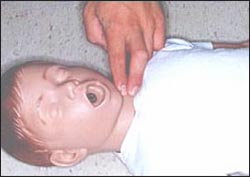
▴ 사진 1-198. 1.
목에서 경동맥이 뛰나 맥을 짚어 알아본다. Copyright ⓒ 2011 John Sangwon Lee, MD., FAAP
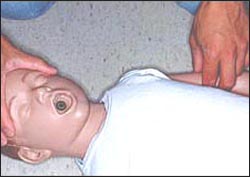
▴ 사진 1-199. 2.
팔꿈치의 앞 부위에서 상완동맥이 뛰나 맥박을 짚어 알아본다. Copyright ⓒ 2011 John Sangwon Lee, MD., FAAP
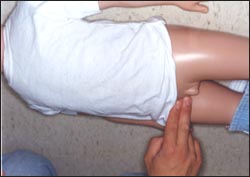
▴ 사진 1-200.3.
서혜부에 있는 대퇴동맥에서 맥이 뛰나 알아본다.Copyright ⓒ 2011 John Sangwon Lee, MD., FAAP
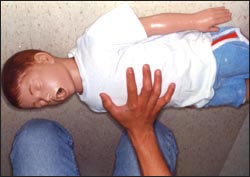
▴ 사진 1-201.4.
가슴에서 심장이 뛰나 알아본다. 1~2초 내에 목이나 팔끔치 앞 부위에서나 서혜부에 있는 동맥에서 맥박이 뛰나 알아보든지 또는 가슴에서 맥박이 뛰나 심장이 뛰나 알아본다. Copyright ⓒ 2011 John Sangwon Lee, MD., FAAP
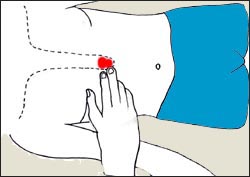
사진 1-202.5.
검상돌기가 있는 부위를 알아본다.
● 색으로 표시한 부분이 검상돌기이다. Copyright ⓒ 2011 John Sangwon Lee, MD., FAAP
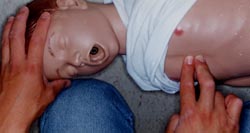
▴ 사진 1-223.6
검상돌기의 끝 부위를 알아본다.
검상돌기는 흉골의 맨 아래쪽에 있고 흉골의 일부이다. 심장 마사지는 흉골 아래 ⅓ 부분에서 한다. 그러나 검상돌기를 압박해서는 안 된다. Copyright ⓒ 2011 John Sangwon Lee, MD., FAAP
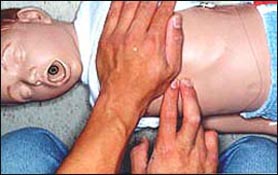
▴ 사진 1-204.7.
처치자의 한쪽 손바닥을 심장 마사지를 할 부위에 올려놓는다.
양쪽 젖꼭지를 잇는 횡선에서 한두 손가락의 넓이만큼 아래 부위, 검상돌기에서 한두 손가락 넓이만큼 위에 있는 흉골부위에서 심장 마사지를 한다. 즉 심장 마사지는 흉골 아래 ⅓부분에서 한다. Copyright ⓒ 2011 John Sangwon Lee, MD., FAAP

▴ 사진 1-205.8.
1세 이하 영아들을 위해 심장 마사지를 할 때는 2~3개의 손가락을 이용해서 하고 매번 심장 마사지를 할 때마다 0.5~1인치 흉골 아래 ⅓ 부위를 눌러 심장 마사지를 한다. 1~8세 유아들이나 학동들을 위해 심장 마사지를 할 때는 손바닥으로 1~1.5인치 흉골 아래 ⅓ 부분을 눌러 한다. 그리고 8세까지 환아들을 위해 심장 마사지를 할 때는 1분에 100 번, 8세 이상부터 성인을 위해서 심장 마사지를 할 때는 1분에 80~100번 한다. Copyright ⓒ 2011 John Sangwon Lee, MD., FAAP
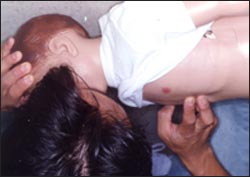
▴ 사진 1-206.9.
혼자만 있을 때는 처치자가 인공호흡도 하고 심장 마사지를 동시 하면서 도와줄 수 있는 사람을 큰 소리로 구한다. Copyright ⓒ 2011 John Sangwon Lee, MD., FAAP
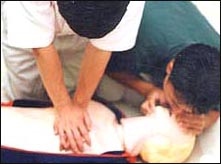
▴ 사진 1-207.10.
두 사람 이상 있을 때는 한 사람은 인공호흡을 하고 다른 사람은 심장 마사지를 한다.
Copyright ⓒ 2011 John Sangwon Lee, MD., FAAP
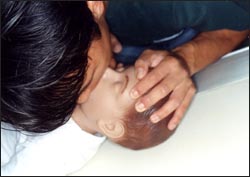
▴ 사진 1-208. 11.
처치자의 입을 환아의 입과 코구멍 두부위에 대고 인공호흡을 하면서 도와줄 수 있는 사람을 큰 소리로 구한다. Copyright ⓒ 2011 John Sangwon Lee, MD., FAAP
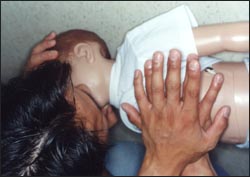
▴ 사진 1-209. 12.
심폐 소생술을 해 줄수 있는 두 사람 이상이 있을 때는 한 사람은 인공호흡을 하고 다른 사 람은 심장 마사지를 한다.Copyright ⓒ 2011 John Sangwon Lee, MD., FAAP
신생아 기본 심폐 소생술 처치법을 설명하면
신생아 기본 심폐 소생술
신생아 기본 심폐 소생술은 영유들이나 학령기 아이들 또는 사춘기 아이들 위한 기본 심폐 소생술과 다른 점이 많다.
| 참고로, 미국에서는 신생아의 건강과 질병을 다루는 모든 의료직에 종사하는 소아청소년과 개업의 및 병원 내에서 신생아 진료를 하는 미 소아청소년과 의사들은 신생아 심폐 소생술 처치법학을 매 2년마다 연수해야하고 신생아 심폐 소생술 처치법 실기 시험과 필기시험에 합격해야 해당 병원 내에서 신생 질병 및 건강관리를 할 수 있는 자격과 권한을 부여받는 것이 보통이다. |
신생아 기본 심폐 소생술을 사진으로 설명하면
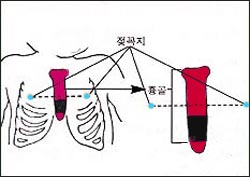
▴ 그림 1-46. 1. 신생아 기본 심폐 소생술을 할 때 검은 색으로 표시된 흉골 부위를 그림 271에서 볼 수 있는 것과 같이 엄지손가락으로 눌러 심장 마사지를 한다. 출처; Textbook of Neonatal Resuscitation. 1987과 소아가정간호백과
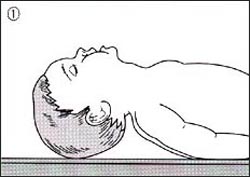
▴ 그림 1-47. 2. 갓 태어난 신생아 기본 심폐 소생술을 할 때 단단하고 편평한 자리에 등을 대고 눕힌다. 목을 뒤로 살짝 젖혀 기도가 더 잘 열리게 한다. 출처; Textbook of Neonatal Resuscitation. 1987과 소아가정간호백과
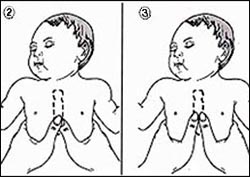
▴ 그림 1-48. 신생아의 흉골의 아래 부위에 양쪽 엄지손가락을 그림 ②과 같이 겹쳐놓거나 그림 ③과 같이 나란히 올려놓고 나머지 손가락으로 아기의 몸통을 싸잡고 심장 마사지를 한다. 출처;Textbook of Neonatal Resuscitation. 1987과 소아가정간호백과
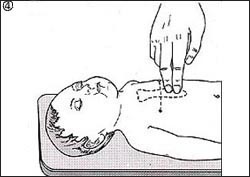
▴ 그림 1-49. 집게손가락과 가운데 손가락의 끝 부분을 그림 ④과 같이 흉골 아래 부위에 올려놓고 신생아의 앞가슴을 등뼈가 있는 쪽을 향해 눌러 심장 마사지를 한다. 출처;Textbook of Neonatal Resuscitation. 1987과 소아가정간호백과

▴ 그림 1-50. 처치자의 한쪽 손으로 신생아의 등을 받치고 다른 쪽 손으로 그림⑤와 같이 심장 마사지를 할 수 있다. 출처; Textbook of Neonatal Resuscitation. 1987과 소아가정간호백과
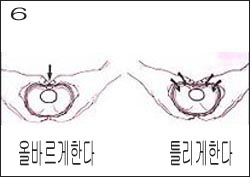
▴ 그림 1-51. 심장 마사지를 할 때 그림 273과 같이 등뼈를 향하여 앞가슴을 수직으로 눌러서 심장 마사지를 한다. 그림 274의 좌와 같이 앞가슴을 눌러서는 안 된다
심장 마사지를 할 때는 인공호흡을 항상 동시에 해야 한다.출처; Used with permission from Textbook of Neonatal Resuscitation. 1987과 소아가정간호백과
-
신생아가 갑자기 숨을 거의 쉬지 못하거나 전혀 쉬지 않을 때나 심장이 아주 비정상적으로 느리게 뛰거나 멈춘 후 바로 인공호흡과 심장 마사지를 통해 기본 신생아 심폐 소생술 또는 전문 신생아 심폐 소생술을 해야 한다(p.00 신생아 심폐 소생술 참조).
-
우선 앞가슴이나 복부가 숨 쉴 때처럼 위쪽으로 올라갔다 내려갔다 움직이나 확인하고 처치자의 귀를 신생아의 입과 코에 대서 숨소리가 나나 또 숨이 뺨에 닿나 체크해본다.
-
숨을 쉬지 않으면 기도를 열어 준다.
-
구강, 콧구멍 속, 인두강 속에 있는 분비물, 구토 물, 가래, 이물 등을 손가락으로 후비어 내든지 흡입구 등으로 흡입해서 제거해서 공기가 기도 속으로 잘 통과하도록 한다.
-
그와 동시에, 손목, 팔꿈치 앞 부위, 서혜부, 목 등에서 맥박이 뛰는지 알아본다.
-
심장이나 맥박이 비정상적으로 아주 느리게 뛰거나, 아주 뛰지 않을 때는 인공호흡과 심장 마사지를 동시 시작한다.
-
그렇지만 신생아가 숨을 못 쉬거나 숨을 쉬지 않을 때 맥박이나 심장 박동이 정상인지 비정상인지 알아보기가 힘들기 때문에 숨을 거의 쉬지 못하거나 숨을 전혀 쉬지 못하면 인공호흡과 심장 마사지를 동시 하는 것이 보통이다.
-
심장 마사지를 하는 방법은 나이와 여러 가지 조건에 따라 조금씩 다르다. 갓 낳은 아기나 영아에게는 다음과 같이 심장 마사지를 한다.
-
갓 낳은 신생아나 영아를 단단하고 편평한 자리에 등을 대고 눕힌다(신생아의 심폐 소생술 그림 ① 참조).
-
처치자의 한쪽 엄지손가락의 끝 부분을 아기의 흉골 아래 ⅓ 부위에 올려놓은 후, 그 엄지손가락의 끝 부분의 위에다 다른 쪽의 엄지손가락의 끝 부분을 올려놓든지(신생아의 심폐 소생술 그림 ②),
-
양쪽 엄지손가락의 끝 부분을 흉골의 아래 ⅓ 부분에 나란히 올려놓는다(신생아의 심폐 소생술 그림 ③). 나머지 양쪽 손의 손가락들과 손바닥으로 아기의 몸통을 싸잡고 심장 마사지를 하든지,
-
한쪽 손의 집게손가락과 가운데 손가락의 끝 부분은 흉골의 아래 ⅓ 부분에 올려놓고 등뼈를 향하여 가슴을 ½∼¾인치(신생아 경우)를, 1~1.5인치(1~8세 아이 경우)를 눌러 좌심실 내 혈액이 대 동맥 혈관을 통과해 전신으로 흘러가도록 심장 마사지를 효율적으로 한다(p.00 신생아의 심폐 소생술 그림 ④).
-
심장 마사지를 신생아에게 할 때는 1분에 100회 한다. 심장 마사지를 3번 한 후 인공호흡을 한 번 한다.
-
-
1∼8세 유아나 학령기 아이나 8세 이상 학령기 아이나 사춘기 아이에게 심장 마사지를 할 때는 심장 마사지를 하는 처치자의 한쪽 손바닥이나 양쪽 손바닥을 환아의 흉골의 중간 부분의 바로 아래 부분에 올려놓고 1분에 100번 정도 한다.
-
2∼2.5초 동안 ‘하나‘라고 소리 내어 세면서 첫 번째 심장 마사지를 해 주고, “둘”이라고 소리 내어 세면서 두 번째 심장 마사지를 하고, “셋” 하고 소리를 내면서 세 번째 심장 마사지를 하고, 바로 그 다음에는 인공호흡을 한 번 한다.
-
그 다음 또다시 같은 요령으로 2∼2.5초 동안에 “하나, 둘, 셋”을 전과 같이 세면서 앞에서와 같이 심장 마사지를 연달아 3번 하고 인공호흡을 한 번 한다.
-
두 사람 이상 처치자가 있을 때는 한 사람은 인공호흡을, 다른 사람은 심장 마사지를 한다. 그렇지만 한 사람만 있을 때는,한 사람이 인공호흡도 하고 심장 마사지를 해 주면서 다른 사람의 도움을 청한다.
-
Cardiac massage(Cardiac compression) in cardiopulmonary resuscitation and newborn basic cardiopulmonary resuscitation in photos 심장 마사지를 하는 법과 신생아 기본 심폐 소생술 처치법을 사진으로 설명하면

▴ Photo 1-198. One. The carotid artery jumps out of the neck, so check the veins. Copyright ⓒ 2011 John Sangwon Lee, MD., FAAP

▴ Photo 1-199. 2. The brachial artery pulsation from the front of the elbow, so check the pulse. Copyright ⓒ 2011 John Sangwon Lee, MD., FAAP

▴ Photo 1-200.3. Check whether the pulse beats in the femoral artery in the groin. Copyright ⓒ 2011 John Sangwon Lee, MD., FAAP

▴ Photo 1-201.4. Find out if your heart is beating in your chest. In 1 to 2 seconds, check whether the pulse is beating in the neck or in front of the elbow or in the artery in the groin, or whether the heart is beating due to a beating pulse in the chest. Copyright ⓒ 2011 John Sangwon Lee, MD., FAAP

Photo 1-202.5. Look for the area with the xiphoid process. ● The part marked in color is the geomsang protrusion. Copyright ⓒ 2011 John Sangwon Lee, MD., FAAP

▴ Photo 1-223.6 Examine the tip of the xiphoid process. The sagittal process is at the very bottom of the sternum and is part of the sternum. Heart massage is done at the lower part of the sternum. However, it should not be pressed against the xiphoid process. Copyright ⓒ 2011 John Sangwon Lee, MD., FAAP

▴ Photo 1-204.7. Place one palm of the therapist on the area where the heart will be massaged. Heart massage is performed in the sternum area below the width of one or two fingers in the horizontal line connecting both nipples, and the width of one or two fingers above the proximal protrusion. In other words, heart massage is done at the lower part of the sternum ⅓. Copyright ⓒ 2011 John Sangwon Lee, MD., FAAP

▴ Photo 1-205.8. When performing a heart massage for infants under the age of 1, use 2-3 fingers, and each time a heart massage is performed, a heart massage is performed by pressing the area under the sternum 0.5 to 1 inch. When performing a heart massage for infants 1-8 years old or schoolchildren, use the palm of your hand to press the area under the sternum of 1 to 1.5 inches. And, when doing heart massage for children up to the age of 8, do 100 times per minute, and when doing cardiac massage for adults from 8 years of age or older, do 80 to 100 times a minute. Copyright ⓒ 2011 John Sangwon Lee, MD., FAAP

▴ Photo 1-206.9. When alone, the therapist performs artificial respiration and heart massage at the same time and calls out loudly for someone who can help. Copyright ⓒ 2011 John Sangwon Lee, MD., FAAP ▴

Photo 1-207.10. When more than one person is present, one person will have artificial respiration and the other will have a heart massage. Copyright ⓒ 2011 John Sangwon Lee, MD., FAAP

▴ Photo 1-208. 11. Place the patient’s mouth on the child’s mouth and the head of the nose hole, and get a person who can help out loudly while performing artificial respiration. Copyright ⓒ 2011 John Sangwon Lee, MD., FAAP

▴ Photo 1-209. 12. When there are two or more people who can provide CPR, one person will give artificial respiration and the other will have a heart massage. Copyright ⓒ 2011 John Sangwon Lee, MD., FAAP
When explaining basic CPR treatments for newborns,
Basic CPR for newborns
- Basic CPR for newborns differs from basic CPR for infants, school-aged or adolescent children.
- For reference, in the United States, pediatric and adolescent practitioners in all medical professions dealing with neonatal health and illness, and U.S. pediatricians and doctors who treat newborns in hospitals, are required to study neonatal CPR every two years.
- It is common to receive qualifications and authority to manage new diseases and health in the hospital only after passing the CPR treatment practice test and written test.
The basic CPR in newborn babies with pictures,

▴ Figure 1-46. 1. When performing basic cardiopulmonary resuscitation for newborn babies, do a heart massage by pressing the sternum area marked in black with your thumb as shown in Figure 271. source; Textbook of Neonatal Resuscitation. Lesson 1987 Pediatric and Family Nursing Encyclopedia

▴ Figure 1-47. 2. When performing basic cardiopulmonary resuscitation for newborn babies, lay your back on a hard, flat surface. Tilt your neck back slightly to open the airways better. source; Textbook of Neonatal Resuscitation. Lesson 1987 Pediatric and Family Nursing Encyclopedia

▴ Figure 1-48. Put both thumbs on the lower part of the newborn’s sternum as shown in Figure ② or put them side by side as shown in Figure ③ and wrap the baby’s torso with the remaining fingers and massage the heart. Source; Textbook of Neonatal Resuscitation. Lesson 1987 Pediatric and Family Nursing Encyclopedia

▴ Figure 1-49. Place the tip of the index finger and middle finger on the lower part of the sternum as shown in Figure ④, and press the newborn’s forearm toward the side of the spine to perform a heart massage. Source; Textbook of Neonatal Resuscitation. Lesson 1987 Pediatric and Family Nursing Encyclopedia

▴ Figure 1-50. One hand of the caregiver can support the newborn’s back, and the other hand can do a heart massage as shown in Figure ⑤. source; Textbook of Neonatal Resuscitation. Lesson 1987 Pediatric and Family Nursing Encyclopedia

▴ Figure 1-51. When performing a heart massage, do a heart massage by pressing the forearm vertically toward the spine as shown in Figure 273. Do not press the front chest as shown on the left in Figure 274.
When doing heart massage, artificial respiration should always be performed at the same time.
- Used with permission from Textbook of Neonatal Resuscitation. Lesson 1987 Pediatric and Family Nursing Encyclopedia Basic neonatal cardiopulmonary resuscitation or specialized neonatal cardiopulmonary resuscitation should be performed immediately after a newborn baby suddenly has little or no breathing, or the heartbeats or stops very abnormally slowly ( newborn baby cardiopulmonary resuscitation) through artificial respiration and heart massage (Reference).
- First of all, check whether the forelimbs or abdomen move upwards and downwards, like when breathing, and check if the patient’s ears are placed on the newborn’s mouth and nose to see if there is a sound of breathing, or if the breath is touching the cheeks.
- If he doesn’t breathe, opens hisr airways.
- The secretions, vomiting fluid, phlegm, foreign body, etc. in the mouth, nostrils, or pharyngeal cavity are cleared out with a finger or inhaled through an inlet to remove the air so that air can pass well into the airways. At the same time, check if the pulse is beating on the wrist, the front of the elbow, the groin, and the neck.
- When the heart or pulse is beating abnormally very slowly or not beating very much, start artificial respiration and heart massage at the same time.
- However, since it is difficult to determine whether a newborn’s breathing or not breathing, whether the pulse or heart rate is normal or abnormal, it is common to perform artificial respiration and heart massage at the same time if he or she can hardly breathe or breathe at all.
- The method of doing a heart massage varies slightly depending on your age and various conditions.
- For a newborn baby or infant, do a heart massage as follows. Lay a newborn baby or infant on their back on a firm and flat surface (refer to the picture of CPR for newborn infants).
- After placing the tip of one thumb of the person on the baby’s sternum under the sternum and then placing the tip of the other thumb on top of the tip of the thumb (CPR picture ② for newborn infants),
- Place the ends of both thumbs side by side on the lower part of the sternum (CPR picture for newborn infants ③). Wrap the baby’s torso with the fingers and palms of both hands and do a heart massage,
- Place the tip of the forefinger and middle finger of one hand on the lower part of the sternum and press ½ to ¾ inch (for newborns) and 1 to 1.5 inch (for 1-8 years old) toward the spine to the left ventricle.
- Efficient cardiac massage so that my blood passes through the aortic vessels and flows to the whole body (CPR picture for newborn babies ④).
- When doing heart massage to a newborn baby, do it 100 times per minute. After three heart massages, give artificial respiration once.
- When performing a heart massage to an infant or school-age child aged 1 to 8, or a school-age child or adolescent child over the age of 8, place one or both palms of the person performing the cardiac massage on the middle part of the child’s sternum and place it under the middle of the child’s sternum and place it at 100 per minute. .
- For 2 to 2.5 seconds, do the first heart massage while counting “one”, do a second heart massage while counting out loud “two”, and do a third heart massage while making a sound “three”
- Next, do one artificial respiration.
- Then, again with the same technique, count “one, two, three” as before for 2 to 2.5 seconds, do heart massage 3 times in succession as before, and artificial respiration once.
- When more than one person is present, one person will give artificial respiration and the other will have a heart massage.
- However, when there is only one person, one person does artificial respiration, gives a heart massage, and asks for help from another person.
출처 및 참조문헌
-
Manual of emergency pediatrics 5th edition, Robert M. Reece, M.D., p.20
-
Manual of emergency pediatrics 4th edition, Robert M. Reece, M.D., p.8
-
Quick Reference to Pediatric Emergencies, Delmer J. Pascoe, M.D., p.39
-
Emergency care and transportation of the sick and injured, 3rd edition, American Academy of orthopedic surgeons. p.77
- The Johns Hopkins Hospital, The Harriet Lane Handbook, 18th& 19th edition
-
Red book 29th-31st Ed 2021
-
Nelson Text Book of Pediatrics 19th-21st Edition
-
Emergency Pediatrics A Guide to Ambulatory Care, Roger M. Barkin, Peter Rosen
-
Ambulatory Pediatrics, Green and Haggerty, Saunders
-
School Health: A Guide For Health Professionals, American Academy of Pediatrics
-
How to really love your child Ross Campbell
-
Good Behavior Stephen W. Garber, Ph.D. and other
-
Adolescent Medicine and The Media Adolescents Medicine
-
AM: Stars Adolescent Medicine: State of the Art Reviews, Asthma, and Diabetes in A
-
The Pediatric Clinics of North America, Adolescent Gynecology, Part II THe Sexually Active Adolescent, August 1999
-
Fueling the Teen Machine, Ellen Shanley and Colleen Thompson
-
Why Teenagers Act the Way They Do, Eight Adolescent Personality Types: Understanding and Dealing With Them, Dr. G. Keith Olson
-
The Pregnancy bible Joan Stone, Keith Eddleman
-
Pediatric and Adolescent Endocrinology, The Pediatric Clinics of North America in August 1987
-
Adolescent Gynecology, Ross Round table
-
Female Reproductive Health, Adolescent Medicine Patricia S. Simmons, M.D., Marc. Laufer, M.D.
-
The Adolescent Male: Adolescent Medicine, David S. Rosen, M.P.H., Michael Rich, M.D.
-
Lesbian and Gay Youth: Care And Counseling, Adolescent Medicine, Caitlin Ryan, M.S.W, A.C.S.W., Donna Futterman, M.D.
-
Medical and Gynecologic Endocrinology: Joseph S. Sanfilippo, M.D., Jordan W. Finkelstein, M.D., Dennis M. Styne. M.D., Adolescent Medicine Clinics, Oct. 2005 Vol. 16
-
Robert T. Brown, M.D., Paula K. Braverman, M.D.
-
Preparing for Adolescence, Dr. James Dobson
-
Dr, Ruth’s Guide to GOOD SEX Ruth Westheimer
-
Dating Sex &Friendship Joyce Huggett
-
진정한 자녀 사랑 나비게이터
-
10대 아들 딸 이렇게 사랑해 키워라 이상원 역
-
소아과학 안효섭 대한교과서
-
의학 용어사전 대한 의사 협회
-
제24권 사춘기 성교육 출처 참조 문헌
-
그 외
Copyright ⓒ 2015 John Sangwon Lee, MD., FAAP
“부모도 반의사가 되어야 한다”-내용은 여러분들의 의사로부터 얻은 정보와 진료를 대신할 수 없습니다.
“The information contained in this publication should not be used as a substitute for the medical care and advice of your doctor. There may be variations in treatment that your doctor may recommend based on individual facts and circumstances. “Parental education is the best medicine.”